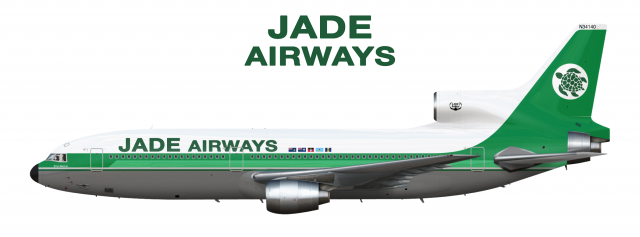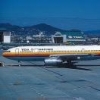Lockheed L1011 | 1980
- Owner: POTKC (View all images and albums)
- Uploaded: Jul 24 2020 10:50 AM
- Views: 793
- Album Jade Air | Wings of the Caribbean
Template by Medviation, livery © POTKC 2020, reproduction or use not permitted without written and explicit consent.

Airline - Jade Airways
Aircraft - Lockheed L1011-500 | N34140
Delivered to LFS, 1980
Leased to Jade Airways, 1980
Returned to LFS, 1986
Sold to Royal Airways, 1986
Stored at Bruntingthorpe, 1994
Scrapped at Bruntingthorpe, 1995
Livery - Standard 1973
Country - Antigua & Barbuda
After seven years of operating around the Caribbean and into the northern end of South America with its small fleet of four DC-9 jets and two HS 748 turboprops, Jade Air management decided that it was time to attempt to compete with the hegemony held by Royal Airways and Aérocontinentale on transatlantic flights from the Caribbean to Europe. For this purpose, a single Lockheed L1011-500 - registered N34140 - was leased via Lockheed Financial Service and put into service on flights from Barbados to London Gatwick with intermediate stops in St Lucia and Antigua. The aircraft was fitted with twenty four First Class seats in a 2-2-2 setup, and 193 Economy Class arranged 2-5-2 (see seatmap below). The first seven rows of Economy Class were also convertible into Business Class, where by sacrificing a maximum of 58 seats in Economy, a maximum of 32 Business Class seats in a 1-3-1 configuration could be created (this capacity was variable depending on demand). This was the first Business Class product in the region, and likely the first ever implementation of a flexible seating configuration, where the capacity of an aircraft in different classes could be changed depending on demand.
Unfortunately, while the flexible Business Class idea was moderately successful, there was not enough demand to justify the entire multi-stop service - Royal Airways' many 747 routes to the Caribbean had saturated the market, and despite the original high hopes Jade Airways was having trouble competing. In 1982 the airline therefore tried to streamline the process, eliminating some of the stops and reversing the Caribbean section of the journey, with the route now operating from Antigua to Barbados and then onwards to London. It was also scaled back to only three weekly rotations, with the L1011 flying from Antigua to New York JFK and Miami on the other days. In 1983, when Royal Airways decided to introduce Concorde service from London Heathrow to Barbados in addition to its existing non-stop 747 flights, the Barbados stop was dropped entirely from Jade Airways' Gatwick route, which became a non-stop, thrice-weekly, direct flight from Antigua. Despite this, the losses kept stacking up, and in 1986 the airline's single L1011-500 was returned to Lockheed - which promptly sold it to a willing customer. The customer, ironically, happened to be Royal Airways.
secy
Thancs
Not bad
Not bad
Thank you
Love the livery. The Heathrow-Barbados Concorde route was non-stop, if you’re going by history. I don’t ever think it went to Bermuda on a regular basis.
Thank you! And yeah I always thought it was non-stop but when I went to check the range while writing this just in case it seems BGI is right at the edge of what's possible in still air with no reserves? So I added Bermuda as a fuel stop. Strange. Anyway, since Royal Airways is meant to be very very heavily inspired by BA, I'll go ahead and change it to non-stop.
Thank you! And yeah I always thought it was non-stop but when I went to check the range while writing this just in case it seems BGI is right at the edge of what's possible in still air with no reserves? So I added Bermuda as a fuel stop. Strange. Anyway, since Royal Airways is meant to be very very heavily inspired by BA, I'll go ahead and change it to non-stop.
Strangely, Concorde flew high enough that upper winds never really mattered. They never altered their track across the Atlantic to account for winds, they were light enough at 50,000+ feet. I’d assume the same going to Barbados.
Strangely, Concorde flew high enough that upper winds never really mattered. They never altered their track across the Atlantic to account for winds, they were light enough at 50,000+ feet. I’d assume the same going to Barbados.
Oh right I see, that's pretty amazing actually...
Oh right I see, that's pretty amazing actually...
Ikr

 Sign In
Sign In Create Account
Create Account













secy